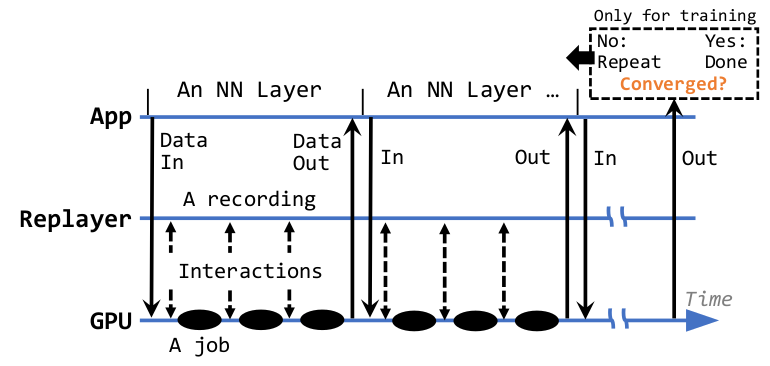GPUReplay is a novel approach to deploy GPU-accelerated computation on mobile and embedded devices which have integrated GPUs. The approach is based on record and replay of GPU executions.
The overview of GPUReplay The developers capture GPU executions on the full GPU stack as a `recording` ahead of time; to reproduce GPU executions, a replayer on target devices runs with the `recording` with new inputs at run time. To capture all the needed information GPUReplay requires to lightly instrument the GPU device drivers, while leaving the userspace GPU runtime and the GPU apps unmodified. The current code release comprises a modified GPU driver (for the Arm Bifrost GPUs) and a userspace replayer.NB: GPUReplay has been tested on Hikey960 with a Mali G71 GPU. We recommend you to use the same platform to avoid unexpected errors/bugs.
As a prototype, GPUReplay currently uses devmem to access physical memory directly. If you want to know more about devmem, read the post. NB: if you are running a prebuilt kernel image, you may not able to use devmem as the operation is not permitted by default. To use it, you need to disable CONFIG_STRICT_DEVMEM in the kernel configuration and build your own image to load.
# go to the midgard directory
$ cd Bifrost-kdriver/driver/product/kernel/drivers/gpu/arm/midgard
# check out the configurations
# modify it as you like and run to build
$ ./build.sh# go to the replayer directory
$ cd replayer
$ source env.sh
$ config-gr
$ build-rls # build replayer
$ build-mod-rls # nano driverTo record GPU execution, build and load the provided GPU driver and run a record harness (your GPU app). The driver then automatically dumps all the necessary information through files as recordings (i.e. register I/O history, page table, memory contents, and synced address spaces).
NB: By design, GPUreplay allows only one GPU context. Once the trace is dumped, it is required to reload a device driver, e.g. for a new recording, remove the currently loaded device driver (rmmod), and load it again (insmod).
We mainly use the ARM Compute Library to test GPUReplay that includes a variety of NN inference examples running on either OpenCL or GLES. Refer to Hikey960 with ACL if you want to produce a recording with ACL.
The replayer maps the physical memory for register I/O to its virtual memory by mmap(). It defines GPU_REG_PA_START, a start physical address where GPU registers are mapped.
Replace it with the one corresponding to your target device.
By default, Hikey960 uses 0xE82C000. If you are not using Hikey960, checkout the device tree for your target platform or look into /proc/iomem to get an appropriate range of physical memory the GPU register are mapped.
When your recordings are ready, you can run the replayer to reproduce the GPU computation. You can load a new input for replaying.
Replaying NN execution with GPUReplayDepending on the recording granularity, you may need to replay recordings multiple times to reproduce the entire computation. In the mean time, you can run CPU computations on the replay results.
NB: before you run the replayer, make sure you unload the stock GPU driver; you should load the replayer kernel that manages GPU memory and interrupts. When you run the replayer, you may need the sudo privilege as the replayer need such a permission to access devmem.
Hacking mobile GPU: document our experience on mobile GPU architecture and driver hacking.
GPUReplay: A 50-KB GPU Stack for Client ML in Proc. ASPLOS 2022
This is a research prototype and we do not guarantee its use or stability. Use at your own risk.
This project is leaded by the XSEL research group.
Heejin Park, Purdue University
Felix Xiaozhu Lin, University of Virginia (formerly at Purdue)



